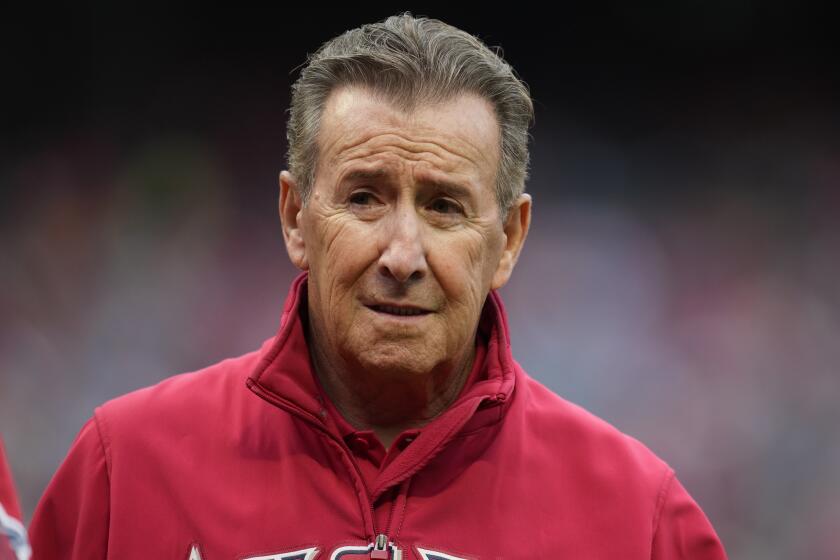Home plate felt much closer to home
Professional baseball got off to a slow start in Southern California.
So slow that in 1898, the San Jose Prune Pickers and the Santa Cruz Beachcombers were chosen over the Los Angeles Angels to join the California League.
Imagine, depriving rival fans the joy of chanting “Beat L.A.!”
But the Angels, their status no doubt elevated when they were purchased by a pool-hall operator, were granted a franchise in the newly organized Pacific Coast League in 1903.
Of course, it was by no means certain that a small, insignificant town like L.A. could support a minor-league club. Some newspapers called the team the Tourists, implying that its stay wouldn’t be long.
But the team developed a faithful following at Chutes Park (capacity: about 8,500), south of Washington Boulevard between Grand Avenue and Main Street.
Two of the most passionate fans of the Angels/Tourists were defense attorney Earl Rogers and his daughter, who grew up to be the author Adela Rogers St. Johns.
One day at Chutes Park, St. Johns recalled years later, “somebody started the yell that became a tradition in the Pacific Coast League. . . . ‘Kill the umpire! We’ll get Earl Rogers to defend you!’ ”
The Angels even had a greeter, the late columnist Matt Weinstock wrote:
“A jovial fellow in a baseball uniform rode a horse slowly through the downtown streets, Main, Spring, Broadway, waving at friends and occasionally blowing a bugle call by way of announcing the baseball game at 2 p.m.”
It was a time, baseball historian Paul Zingg wrote, when ballparks were “shaped by the city blocks on which they were built, home to players who often lived in the same neighborhood as the fans.”
Chutes Park was moved slightly east after the 1910 season when Hill Street, which then dead-ended at Washington, was extended south. The stadium was renamed Washington Park and several Angels were on the construction crew, including pitcher Frank Murphy, “who dug holes [and] surveyed,” The Times reported.
Meanwhile, the Pacific Coast League installed another team in the industrial town of Vernon.
After a squabble with the city, however, the Vernon Tigers moved to Venice in 1913. It wasn’t just the team that moved. Co-owner Eddie Maier dismantled the stands, fences and clubhouses and took everything along, writer Jay Berman later noted in The Times.
But attendance was disappointing in Venice, and the prodigal club returned to Vernon in 1915, trucking the stadium back again.
The appeal of otherwise humble Vernon and Venice was that they were the only towns in Los Angeles County where alcohol could be purchased.
The left-field area of Vernon’s Maier Park featured an entrance to Doyle’s Thirst Emporium, which boasted a 100-foot-long counter. Vernon left fielder Jess Stovall was known to step into the joint for a drink between innings. The Vernon Chamber of Commerce now occupies the saloon site.
In 1925, Washington Park was forced to close when the third base area was condemned by the city. It wasn’t the third baseman’s fault. The city wanted to extend Broadway south from Washington Boulevard, and third base was blocking the way.
So the team was purchased by chewing-gum magnate William Wrigley, who moved the Angels into a new stadium at 42nd Place and Avalon Boulevard, now Gilbert Lindsay Recreation Center.
L.A.’s Wrigley Field (not to be confused with the Chicago stadium) was larger than Washington Park. But it was still intimate enough, Zingg wrote, that Angels slugger Lou Novikoff could find inspiration by “having his wife sit in a box seat behind home plate with instructions to taunt him as loudly as she could.”
The Vernon Tigers went through several more owners, including comic Fatty Arbuckle, who complained that the games made him too nervous. The Tigers later reconnected with the showbiz world when they adopted a new name in 1938, the Hollywood Stars.
The team’s home was Gilmore Field, now the site of CBS’ Television City. The real stars were such fans as Bob Hope, Bing Crosby and Humphrey Bogart, who sat in the stands rather than seek shelter in executive suites as celebrities do today.
Mobster Mickey Cohen occupied a box right behind the Stars’ dugout. The understanding among the players “was that if anybody in [Cohen’s] box said anything, just smile and wave,” Stars first baseman Chuck Stevens told baseball historian Dick Dobbins. Cohen, luckily, was never known to issue the order, “Kill the umpire!”
In late 1957, the major leagues came to the West Coast and that was the end for the local Pacific Coast League teams and, soon after, their little ballparks.
The Los Angeles Angels name, of course, lives on in Anaheim.
The Hollywood Stars, on the other hand, are just a memory, though a more vivid one than the San Jose Prune Pickers and the Santa Cruz Beachcombers.
--
steveharvey9@gmail.com
More to Read
Go beyond the scoreboard
Get the latest on L.A.'s teams in the daily Sports Report newsletter.
You may occasionally receive promotional content from the Los Angeles Times.






